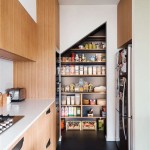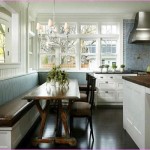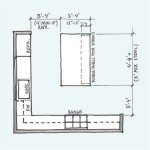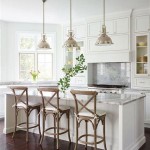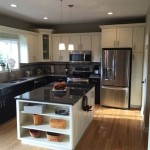Determining the Appropriate Backsplash Coverage in Your Kitchen
Kitchen backsplashes serve a dual purpose: protecting the walls from splashes and spills, and enhancing the overall aesthetic of the kitchen design. Deciding how much wall area to cover with a backsplash requires careful consideration of both functional requirements and design preferences. Various factors, including countertop material, cabinet height, cooking style, and personal taste, influence the optimal backsplash height and extent.
The term “backsplash” typically refers to the material installed on the wall behind a countertop, primarily above the range, sink, or other work areas. The fundamental aim is to create a surface that is easy to clean and resistant to moisture, grease, and food splatters. Historically, backsplashes were relatively utilitarian, focusing solely on practicality. However, modern kitchen design increasingly incorporates backsplashes as a key design element, contributing significantly to the kitchen's overall visual appeal.
The decision of how much backsplash to install is not always straightforward. It involves weighing the benefits of extensive coverage against the cost, design considerations, and potential impact on the kitchen's visual balance. A minimal backsplash may suffice for certain cooking styles and kitchen layouts, while other situations may necessitate a more comprehensive approach.
Standard Backsplash Height: The 4-Inch Rule and Beyond
A common starting point for backsplash height is the traditional 4-inch backsplash, often integrated with the countertop material. This approach is typically less expensive than full backsplash coverage and provides a basic level of protection against spills. However, its effectiveness is limited, particularly behind the range where splattering is more prevalent. The 4-inch backsplash is generally suitable for kitchens where cooking is infrequent or primarily involves minimal splattering, and where the budget is a primary concern.
Beyond the 4-inch standard, the most popular height is typically considered to be the distance between the countertop and the underside of the upper cabinets. This dimension typically ranges from 15 to 18 inches. This height provides ample protection for the wall space most susceptible to splashes and spills while creating a visually balanced transition between the countertop and the upper cabinets. It also allows for a wide variety of backsplash materials and designs to be incorporated without overwhelming the kitchen space.
When upper cabinets are not present, determining the appropriate backsplash height requires a different approach. In these scenarios, the backsplash can extend higher, perhaps two-thirds of the way up the wall or even to the ceiling. The advantage here is increased wall protection, and a more dramatic visual impact. The aesthetic consideration then becomes how the extended backsplash relates to other design elements in the kitchen, such as windows, decorative shelving, or artwork.
Factors Influencing Backsplash Height: Practical Considerations
Several practical factors should be considered when deciding on the backsplash height. The primary function of the backsplash is to protect the wall from damage, so the level of protection needed will depend on the type of cooking that takes place in the kitchen. A kitchen where frying, sautéing, and other high-splatter cooking methods are common will require a taller backsplash than a kitchen where cooking is primarily limited to baking or microwaving.
The countertop material also influences the backsplash decision. If the countertop is made of a porous material, such as certain types of natural stone, it may be more susceptible to staining and damage from spills. In these cases, a taller backsplash can act as a barrier to prevent liquids from running down the wall and onto the countertop. Similarly, the type of wall paint can impact the need for a backsplash. Walls painted with a matte finish are more difficult to clean than walls painted with a semi-gloss or gloss finish, making a backsplash a crucial element for easy maintenance.
The location of the sink is another important factor. Splashing is common around the sink, so a backsplash should extend at least a few inches above the sink basin to provide adequate protection. The presence of a kitchen island or peninsula with a sink also warrants consideration. In these situations, the backsplash might need to extend further horizontally along the wall to protect the area around the sink.
Another practical consideration is the presence of electrical outlets and switches. When installing a backsplash, it is important to ensure that these are properly accommodated. This might involve cutting tiles to fit around the outlets and switches or using a backsplash material that can be easily cut and shaped. Planning for the placement of electrical components during the backsplash installation process is crucial to avoid complications and ensure a professional finish.
Design Considerations: Integrating the Backsplash into the Kitchen Aesthetic
Beyond the practical considerations, the aesthetic impact of the backsplash is a significant factor. The backsplash can be a powerful design element that can tie together the various elements of the kitchen, such as the countertops, cabinets, and appliances. The choice of material, color, pattern, and texture can significantly impact the overall feel of the kitchen.
The size of the kitchen should also be considered. In a small kitchen, a large and visually busy backsplash can overwhelm the space, making it feel even smaller. In these situations, a simpler backsplash with a light color and minimal pattern can help to create a sense of spaciousness. Conversely, in a large kitchen, a more dramatic backsplash can add visual interest and prevent the space from feeling too sterile.
The style of the kitchen is another important factor. A traditional kitchen might call for a classic backsplash material, such as subway tile or marble, while a modern kitchen might benefit from a more contemporary material, such as glass or stainless steel. The color of the backsplash should also complement the other colors in the kitchen. A backsplash can be used to add a pop of color to a neutral kitchen or to tie together a kitchen with a more colorful palette.
The lighting in the kitchen also influences the backsplash decision. A dark backsplash can absorb light, making the kitchen feel darker, while a light backsplash can reflect light, making the kitchen feel brighter. The type of lighting also matters. Under-cabinet lighting can highlight the texture and detail of a backsplash, while recessed lighting can provide a more even illumination.
Finally, personal taste plays a significant role in determining the appropriate backsplash coverage. Some homeowners prefer a minimalist approach, opting for a simple backsplash that provides basic protection without drawing too much attention. Others prefer a more maximalist approach, using the backsplash as an opportunity to express their creativity and add a unique design element to their kitchen. The key is to choose a backsplash that reflects the homeowner's personal style and complements the overall aesthetic of the kitchen.
In summary, determining the appropriate backsplash coverage in a kitchen involves a careful consideration of both functional requirements and design preferences. By considering the various factors discussed above, homeowners can make an informed decision that will result in a beautiful and functional kitchen space.

How To Install A Kitchen Backsplash The Best And Easiest Tutorial

Kitchen Backsplashes What Are They Do You Need Them

How Much Does A Marble Backsplash Cost To Install 2025 Data Angi

How Much Tile Do I Need For My Kitchen Backsplash Transworld Northridge

Kitchen Backsplash Installation Cost What Is It In Tucson

How Much Should You Budget For Your Kitchen Countertops Backsplashes And Flooring

Choosing Between A Standard And Full Kitchen Backsplash

What Size Tile For Kitchen Backsplash Finding The Right Fit

Full Height Backsplashes Pros Cons And Options Stone Central

Kitchen Backsplashes What Are They Do You Need Them

